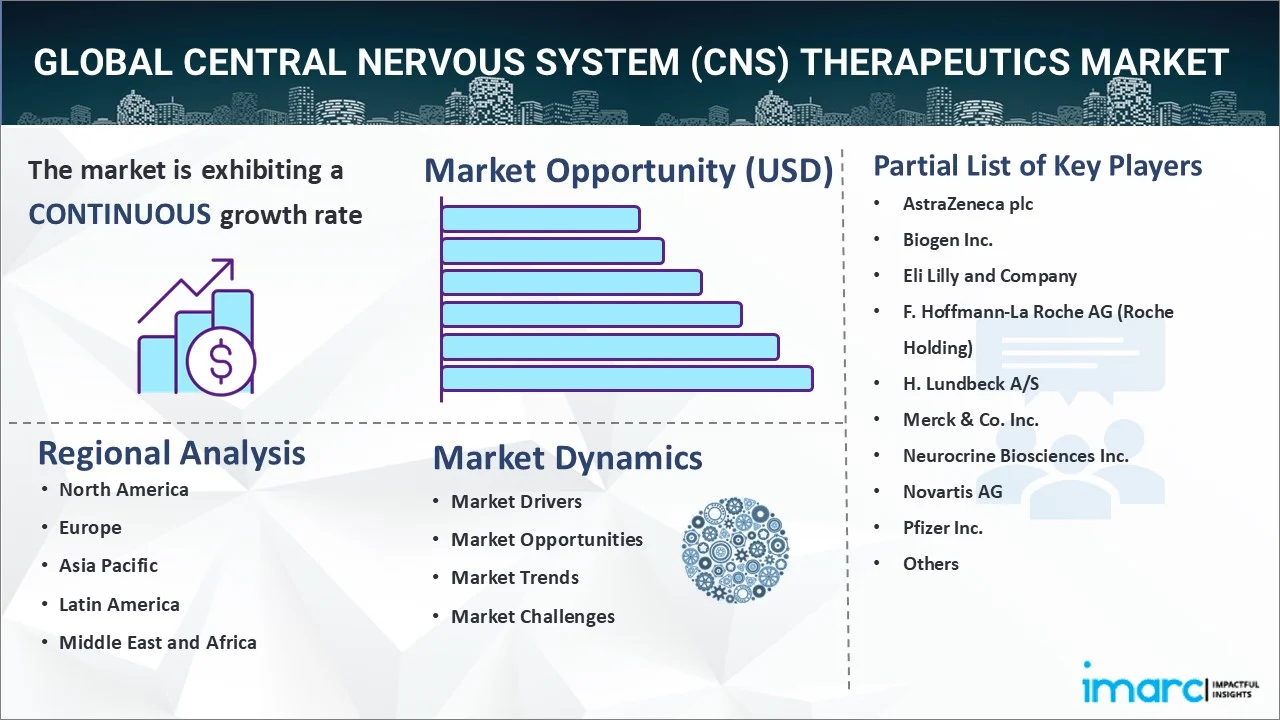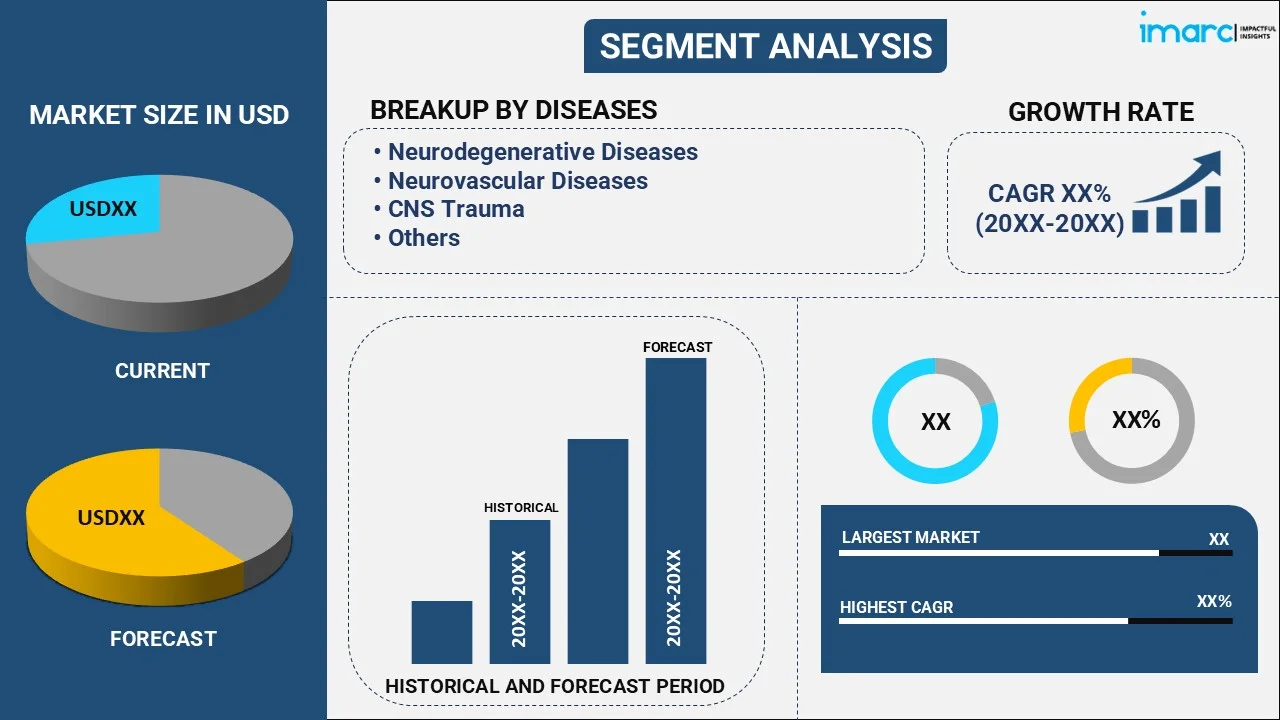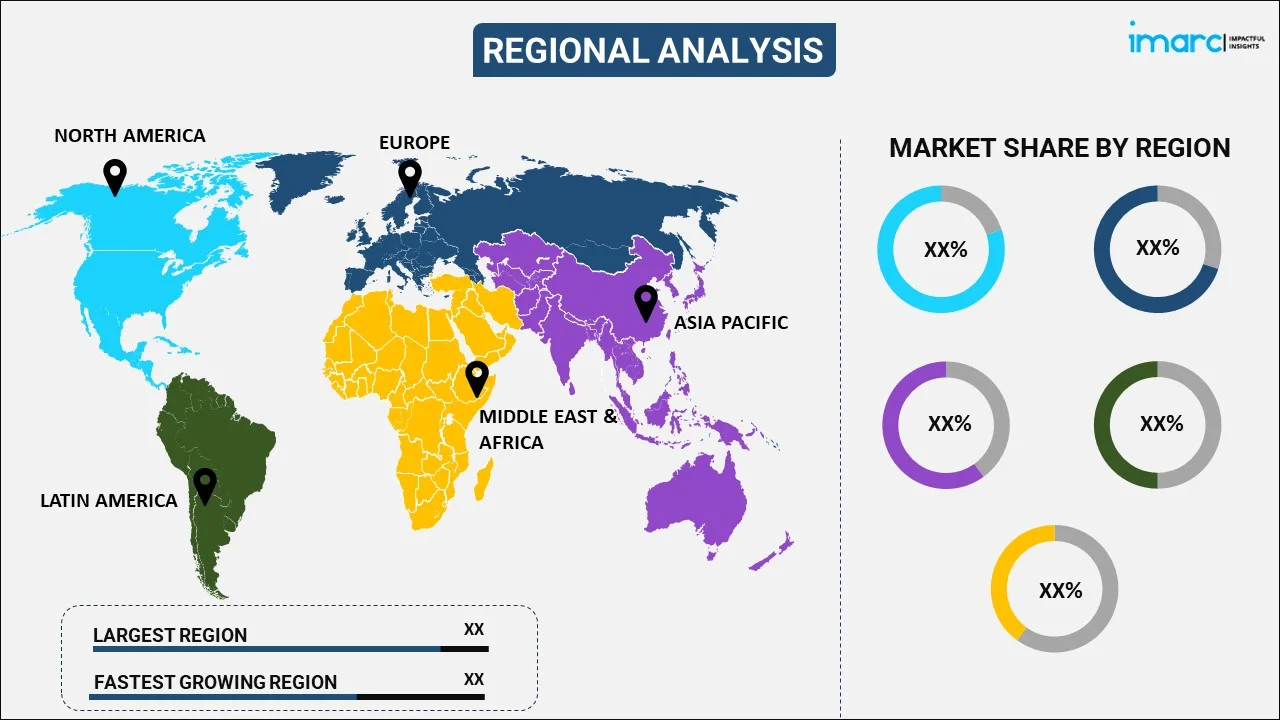
Central Nervous System (CNS) Therapeutics Market Report by Disease (Neurodegenerative Diseases, Neurovascular Diseases, CNS Trauma, Mental Health, Infectious Diseases, CNS Cancer, and Others), Application (Hospital, Clinic, Homecare, and Others), and Region 2025-2033
Market Overview:
The global central nervous system (CNS) therapeutics market size reached USD 148.7 Billion in 2024. Looking forward, IMARC Group expects the market to reach USD 257.3 Billion by 2033, exhibiting a growth rate (CAGR) of 5.64% during 2025-2033. The growing prevalence of neurological and psychiatric disorders among the masses, the rise in telehealth and telemedicine services, and the increase in trade agreements and partnerships are among the key factors driving the market growth.
|
Report Attribute
|
Key Statistics
|
|---|---|
|
Base Year
|
2024 |
|
Forecast Years
|
2025-2033
|
|
Historical Years
|
2019-2024
|
| Market Size in 2024 | USD 148.7 Billion |
| Market Forecast in 2033 | USD 257.3 Billion |
| Market Growth Rate (2025-2033) | 5.64% |
Central nervous system (CNS) therapeutics focus on the treatment and management of disorders affecting the brain and spinal cord, which make up the central nervous system. These disorders can range from neurodegenerative diseases, such as Alzheimer's and Parkinson's to psychiatric conditions such as depression and anxiety. They also cover acute conditions, including traumatic brain injuries and strokes. The treatment landscape is vast and includes various approaches, such as pharmacological interventions, surgical procedures, and newer modalities, including gene therapy. Medications can consist of antidepressants, antipsychotics, or drugs specifically designed to target neural pathways. Research in this field is continually evolving, driven by advancements in neuroscience and biotechnology.

One of the primary market drivers for the central nervous system (CNS) therapeutics industry is the rising prevalence of neurological and psychiatric disorders globally. Conditions such as Alzheimer's, Parkinson's, depression, and anxiety are becoming increasingly common due to factors, such as an aging population, lifestyle changes, and environmental stressors. With an increasing number of patients requiring CNS therapeutics, the market potential continues to expand, making it an attractive area for investment and innovation. Along with this, the rise in telehealth and telemedicine services is proving to be a significant driver in the market growth. The COVID-19 pandemic has accelerated the adoption of remote healthcare, and this trend is likely to continue. Telehealth services make it more convenient for patients to seek medical advice and obtain prescriptions for CNS disorders without the need for physical appointments. This increased accessibility is particularly beneficial for those in remote areas, broadening the patient base for CNS therapeutics. In addition, regulatory agencies are showing an increased willingness to fast-track the approval of innovative CNS therapeutic drugs, particularly those addressing unmet medical needs. Therefore, it is contributing to the market. Moreover, trade agreements and partnerships are often facilitated by globalization, providing a more streamlined distribution network for CNS therapeutic products, and creating a positive market outlook.
Central Nervous System (CNS) Therapeutics Market Trends/Drivers:
Technological Advancements in Drug Discovery
The rapid advancements in technology have been a crucial driver for the CNS therapeutics industry. Traditional methods of drug discovery are being augmented by technologies such as artificial intelligence (AI), machine learning, and big data analytics. These technologies help in quicker identification of potential drug candidates, thereby speeding up the process of drug development. High-throughput screening methods have also become more sophisticated, allowing researchers to evaluate thousands of compounds in a shorter time frame. Bioinformatics tools and computational models are increasingly used for understanding disease pathways at the molecular level, aiding in the development of targeted therapies. These technological strides have significantly reduced the time and cost associated with bringing a new CNS therapeutic drug to market, providing a robust impetus for industry growth.
Public Awareness and Healthcare Infrastructure
Public awareness about mental health and neurological disorders has grown significantly in recent years. This increased awareness has led to early diagnosis and treatment, subsequently driving the demand for CNS therapeutics. Furthermore, governments and healthcare organizations are increasingly recognizing the importance of mental health, leading to better healthcare infrastructure and policies that facilitate the development and distribution of CNS drugs. In many developed countries, insurance coverage has expanded to include treatments for neurological and psychiatric disorders, making therapies more accessible to a broader population. The rise in specialized healthcare facilities, such as neurology clinics and rehabilitation centers, adds another layer of market potential for CNS therapeutics. As healthcare infrastructure continues to improve, so does the market for effective and innovative CNS treatments.
Growing Investment in Research and Development
Research and development (R&D) form the backbone of the CNS therapeutics industry, and growing investment in this area serves as a substantial market driver. Additionally, pharmaceutical companies are dedicating significant resources to R&D activities, often in collaboration with academic institutions and research organizations. Such partnerships facilitate the sharing of expertise and financial resources, thereby expediting the development process. In addition, government grants, venture capital funding, and public-private partnerships are also playing an increasing role in supporting R&D efforts. This collaborative environment has led to groundbreaking discoveries, including targeted therapies and personalized medicine approaches for treating CNS disorders. The promise of high returns on investment, coupled with the ever-present demand for effective treatments, ensures that R&D funding remains a strong driver for the growth of the CNS Therapeutics industry.
Central Nervous System (CNS) Therapeutics Industry Segmentation:
IMARC Group provides an analysis of the key trends in each segment of the central nervous system (CNS) therapeutics market report, along with forecasts at the global, regional and country levels for 2025-2033. Our report has categorized the market based on disease and application.
Breakup by Disease:

- Neurodegenerative Diseases
- Alzheimer's Disease
- Parkinson’s Disease
- Multiple Sclerosis
- Huntington's Disease
- Amyotrophic Lateral Sclerosis
- Others
- Neurovascular Diseases
- CNS Trauma
- Mental Health
- Anxiety Disorders
- Epilepsy
- Mood Disorders
- Psychotic Disorders
- Others
- Infectious Diseases
- CNS Cancer
- Others
Neurodegenerative Diseases represent the largest market share
The report has provided a detailed breakup and analysis of the market based on the disease. This includes neurodegenerative diseases (Alzheimer's disease, Parkinson’s disease, multiple sclerosis, Huntington's disease, amyotrophic lateral sclerosis, and others), neurovascular diseases, CNS trauma, mental health (anxiety disorders, epilepsy, mood disorders, psychotic disorders, and others), infectious diseases, CNS cancer, and others. According to the report, neurodegenerative diseases accounted for the largest market share.
The rising incidence of neurodegenerative diseases, such as Alzheimer's, Parkinson's, and Multiple Sclerosis is a significant market driver in the central nervous system (CNS) Therapeutics industry. As the global population ages, the prevalence of these conditions is expected to escalate, increasing the demand for effective treatments. Along with this, the socioeconomic burden these diseases place on healthcare systems and families is pushing both public and private sectors to invest heavily in research and development. Technological advancements, such as biomarker identification and gene editing, are accelerating the pace of drug discovery for neurodegenerative conditions, attracting further investment. Additionally, government initiatives and regulatory support, mainly fast-track approvals and grants, provide an impetus for pharmaceutical companies to develop innovative solutions. In addition, the growing public awareness and educational campaigns around neurodegenerative diseases are also contributing to market growth by encouraging early diagnosis and treatment. All these factors collectively create a conducive environment for the expansion of the CNS Therapeutics market in the domain of neurodegenerative diseases.
Breakup by Application:
- Hospital
- Clinic
- Homecare
- Others
A detailed breakup and analysis of the market based on the application has also been provided in the report. This includes hospital, clinic, homecare, and others.
The role of hospitals as a primary point of care for acute and chronic neurological conditions is a significant market driver in the central nervous system (CNS) therapeutics industry. Hospitals are often equipped with advanced diagnostic tools and treatment facilities, making them essential for managing complex CNS disorders. As cases of traumatic brain injuries, strokes, and emergency psychiatric episodes continue to rise, the need for specialized CNS therapeutics within hospital settings becomes increasingly crucial. The demand is further fueled by the growing number of specialized neurology departments and centers of excellence in hospitals, which require a consistent supply of CNS medications and treatments. Additionally, hospitals are key sites for clinical trials, accelerating the adoption of innovative CNS therapies.
On the contrary, the rising trend towards homecare for managing chronic and post-acute conditions is significantly influencing the Central Nervous System (CNS) therapeutics industry. As technological advancements make remote monitoring and telehealth more viable, many patients prefer receiving care in the comfort of their homes. Homecare is especially relevant for the elderly population and patients with neurodegenerative disorders who may find frequent hospital visits cumbersome. In addition, the availability of easy-to-administer medications and therapies suitable for home use is driving demand in this segment. Moreover, healthcare models are shifting towards more patient-centric approaches, further encouraging the adoption of homecare solutions. These trends not only broaden the consumer base but also open new channels for the distribution of CNS therapeutics, boosting overall market growth.
Breakup by Region:

- North America
- United States
- Canada
- Asia Pacific
- China
- Japan
- India
- South Korea
- Australia
- Indonesia
- Others
- Europe
- Germany
- France
- United Kingdom
- Italy
- Spain
- Russia
- Others
- Latin America
- Brazil
- Mexico
- Others
- Middle East and Africa
North America exhibits a clear dominance, accounting for the largest central nervous system (CNS) therapeutics market share
The market research report has also provided a comprehensive analysis of all the major regional markets, which include North America (the United States and Canada); Asia Pacific (China, Japan, India, South Korea, Australia, Indonesia, and others); Europe (Germany, France, the United Kingdom, Italy, Spain, Russia, and others); Latin America (Brazil, Mexico, and others); and the Middle East and Africa. According to the report, North America exhibited the largest market segment.
The central nervous system (CNS) therapeutics industry in North America is driven by the high prevalence of CNS-related disorders, including mental health conditions, neurodegenerative diseases, and acute neurological issues. According to the Centers for Disease Control and Prevention (CDC), one in five American adults experiences mental illness each year. Furthermore, an aging population in the region significantly contributes to the increased incidence of age-related neurodegenerative diseases such as Alzheimer's and Parkinson's.
In addition, technological innovation is another significant driver, with North America often leading in the development of advanced treatments, including gene therapies and neural implants. The region also benefits from strong regulatory support, with agencies providing fast-track approvals for innovative CNS drugs. Moreover, robust healthcare infrastructure, including advanced hospitals and a growing focus on telehealth services, facilitates easier access to treatments. Furthermore, substantial investment in research and development, both from public and private sectors, furthers innovation and the speed-to-market for new CNS therapies, collectively making North America a dynamic market for CNS therapeutics.
Competitive Landscape:
The key players are allocating significant resources to advance their understanding of CNS disorders, uncover novel treatment approaches, and develop new therapeutic agents. This involves conducting clinical trials, and preclinical studies, and leveraging cutting-edge technologies to identify potential drug candidates. Along with this, brands are leveraging advanced techniques, such as high-throughput screening, molecular modeling, and genetics to discover compounds with the potential to modulate CNS-related targets. These efforts aim to identify effective drug candidates that can address specific neurological conditions. In addition, the growing focus on personalized medicine within the CNS therapeutics field is positively influencing the market. Apart from this, companies are particularly focused on neurodegenerative diseases such as Alzheimer's, Parkinson's, and ALS. Research efforts are aimed at unraveling the underlying mechanisms of these diseases and developing disease-modifying treatments, which act as another growth-inducing factor. Furthermore, the escalating number of collaborations with research institutions, academia, and other industry players to develop new therapeutic approaches is contributing to the market.
The market research report has provided a comprehensive analysis of the competitive landscape in the market. Detailed profiles of all major companies have also been provided. Some of the key players in the market include:
- AstraZeneca plc
- Biogen Inc.
- Eli Lilly and Company
- F. Hoffmann-La Roche AG (Roche Holding)
- H. Lundbeck A/S
- Merck & Co. Inc.
- Neurocrine Biosciences Inc.
- Novartis AG
- Pfizer Inc.
- Sanofi S.A.
- Takeda Pharmaceutical Company Limited
- Teva Pharmaceutical Industries Ltd.
Recent Developments:
- In May 2023, AstraZeneca plc gained authorization from the Japanese Ministry of Health, Labour, and Welfare (MHLW) to use Ultomiris (ravulizumab) to stop relapses in patients with neuromyelitis optica spectrum disease (NMOSD), including neuromyelitis optica.
- In January 2023, Biogen Inc. and Alcyone Therapeutics (Alcyone) engaged in a licence and cooperation agreement to create the ThecaFlex DRxTM System from Alcyone, an implanted medical device designed for subcutaneous antisense oligonucleotide (ASO) therapy administration into the intrathecal space.
- In January 2023, Capsida Biotherapeutics Inc. established a multi-year strategic partnership to develop game-changing genetic treatments for critical illnesses with Prevail Therapeutics ("Prevail"), a fully owned subsidiary of Eli Lilly and Company ("Lilly").
Central Nervous System (CNS) Therapeutics Market Report Scope:
| Report Features | Details |
|---|---|
| Base Year of the Analysis | 2024 |
| Historical Period | 2019-2024 |
| Forecast Period | 2025-2033 |
| Units | Billion USD |
| Scope of the Report | Exploration of Historical Trends and Market Outlook, Industry Catalysts and Challenges, Segment-Wise Historical and Predictive Market Assessment:
|
| Diseases Covered |
|
| Applications Covered | Hospital, Clinic, Homecare, Others |
| Regions Covered | North America, Asia Pacific, Europe, Latin America, Middle East and Africa |
| Countries Covered | United States, Canada, China, Japan, India, South Korea, Australia, Indonesia, Germany, France, United Kingdom, Italy, Spain, Russia, Brazil, Mexico |
| Companies Covered | AstraZeneca plc, Biogen Inc., Eli Lilly and Company, F. Hoffmann-La Roche AG (Roche Holding), H. Lundbeck A/S, Merck & Co. Inc., Neurocrine Biosciences Inc., Novartis AG, Pfizer Inc., Sanofi S.A., Takeda Pharmaceutical Company Limited, Teva Pharmaceutical Industries Ltd., etc. |
| Customization Scope | 10% Free Customization |
| Post-Sale Analyst Support | 10-12 Weeks |
| Delivery Format | PDF and Excel through Email (We can also provide the editable version of the report in PPT/Word format on special request) |
Key Benefits for Stakeholders:
- IMARC’s industry report offers a comprehensive quantitative analysis of various market segments, historical and current market trends, market forecasts, and dynamics of the central nervous system (CNS) therapeutics market from 2019-2033.
- The research report provides the latest information on the market drivers, challenges, and opportunities in the global central nervous system (CNS) therapeutics market.
- The study maps the leading, as well as the fastest-growing, regional markets. It further enables stakeholders to identify the key country-level markets within each region.
- Porter's five forces analysis assist stakeholders in assessing the impact of new entrants, competitive rivalry, supplier power, buyer power, and the threat of substitution. It helps stakeholders to analyze the level of competition within the central nervous system (CNS) therapeutics industry and its attractiveness.
- Competitive landscape allows stakeholders to understand their competitive environment and provides an insight into the current positions of key players in the market.
Key Questions Answered in This Report
The global Central Nervous System (CNS) therapeutics market was valued at USD 148.7 Billion in 2024.
We expect the global Central Nervous System (CNS) therapeutics market to exhibit a CAGR of 5.64% during 2025-2033.
The increasing prevalence of mental illness, along with the growing adoption of CNS therapeutics in the treatment procedures of Parkinson’s disease, spinal cord injury, epilepsy, etc., is primarily driving the global Central Nervous System (CNS) therapeutics market.
he sudden outbreak of the COVID-19 pandemic has led to the rising incidences of anxiety, depression, hypertension, etc., among patients suffering from the coronavirus infection, thereby augmenting the demand for Central Nervous System (CNS) therapeutics.
Based on the disease, the global Central Nervous System (CNS) therapeutics market can be segmented into neurodegenerative diseases, neurovascular diseases, CNS trauma, mental health, infectious diseases, CNS cancer, and others. Currently, neurodegenerative diseases hold the majority of the total market share.
On a regional level, the market has been classified into North America, Asia-Pacific, Europe, Latin America, and Middle East and Africa, where North America currently dominates the global market.
Some of the major players in the global Central Nervous System (CNS) therapeutics market include AstraZeneca plc, Biogen Inc., Eli Lilly and Company, F. Hoffmann-La Roche AG (Roche Holding), H. Lundbeck A/S, Merck & Co. Inc., Neurocrine Biosciences Inc., Novartis AG, Pfizer Inc., Sanofi S.A., Takeda Pharmaceutical Company Limited, and Teva Pharmaceutical Industries Ltd.
Need more help?
- Speak to our experienced analysts for insights on the current market scenarios.
- Include additional segments and countries to customize the report as per your requirement.
- Gain an unparalleled competitive advantage in your domain by understanding how to utilize the report and positively impacting your operations and revenue.
- For further assistance, please connect with our analysts.
 Inquire Before Buying
Inquire Before Buying
 Speak to an Analyst
Speak to an Analyst
 Request Brochure
Request Brochure
 Request Customization
Request Customization




.webp)




.webp)












